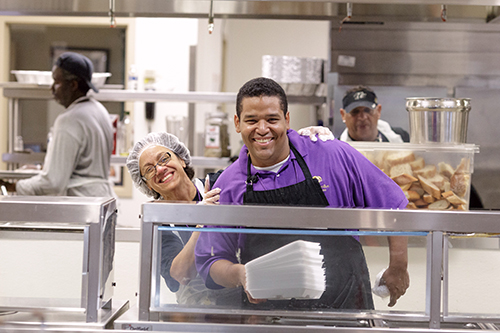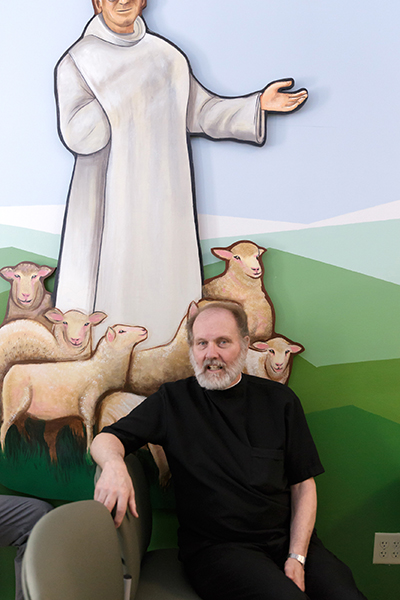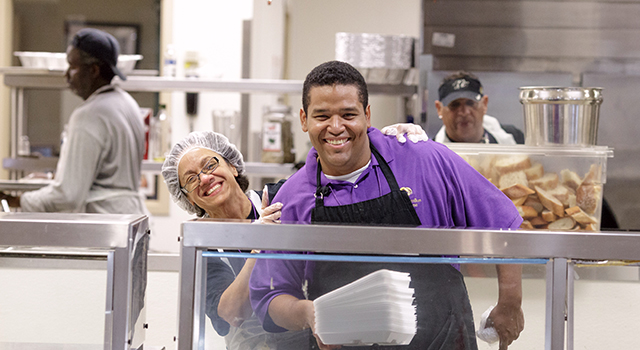By Tom Tracy - Florida Catholic

Photographer: TOM TRACY | FC
In this file photo from 2016, Eva Quesada, a Camillus House volunteer, and Carlos Martinez, a member of the kitchen staff, share a laugh in the center's dining room.
MIAMI | As one chapter in Camillus House’s long history of helping Miami’s homeless comes to a close this June, another is set to begin this March.
Since 2003, the Catholic-affiliated Camillus House has developed and expanded services through its “day center,” a drop-in center where many of the homeless and street people in Miami could find a safe harbor during business hours.
Located at the agency’s main site downtown, the center provided a place where the homeless could get a hot meal, take a shower, pick out new clothes and even receive and send mail, attend classes and consult with on-site counselors and social workers.
A federal grant enabled Camillus to care for 150 men and women at the center, but the shelter managed to serve an average of 340 persons daily.
But changes in the way the federal Department of Housing and Urban Development wants to address homelessness in America resulted in a decision recently to end funding for the drop-in center, and Camillus has begun to wind down its services, according to spokesman Sam Gil. As of Feb. 10, the day center began limiting its services to 150 individuals on a first come/first serve basis.
The federal financial support was disbursed locally through the county’s Homeless Trust, which recently provided emergency gap funding to help Camillus in the short term.
Outreach to Miami’s homeless population first began at Camillus House in the 1960s. The shelter has always been operated by the Little Brothers of the Good Shepherd, a small U.S.-based order that merged with the worldwide Hospitaller Brothers of St. John of God in 2015.
Six decades after it began, Camillus House has grown from a small overnight shelter into a full service center, spread across a series of new buildings and offering a comprehensive system of care for the poor and homeless, including food, clothing, emergency, transitional and permanent housing, physical and mental health care, and substance abuse treatment.

Photographer: TOM TRACY | FC
In this file photo from 2016, Hospitaller Brother Mateo Fenza poses in front of the mural of the "lost sheep" in the chapel, one of the new Camillus House buildings. The former soup kitchen now includes a behavioral health treatment and residential facility, medical and service space, dining hall and cafe, parking garage, commercial kitchen, offices, educational spaces, and an auditorium.
The drop-in center proved a valuable forum for Camillus staff to better know Miami’s street population on a more individual level and to find them assistance they would not have received otherwise.
“It had given us a chance to do outreach with them, to help them get into treatment programs, behavior-health counseling and to help these folks break the cycle of homelessness,” Gil said, noting that unless private funding sources step forward to bridge an estimated $1 million annual budget, the program will continue to be cut back until it is fully closed at the end of June 2017.
With an estimated daily street population of upwards of 800 persons in Miami, Gil said the closure of the drop-in center means a lot more chronically homeless individuals will have to find other places to go during business hours.
“It is not ideal, it is not what we want to do,” Gil said, “but we have to look out for the 1,100 individuals we house on any given night at 13 locations, and we continue to serve close to 500 meals daily just at this campus. And we are still providing showers for some daily.”
An estimated 30 percent of chronically homeless persons are thought to be severely mentally ill, and many others are physically disabled. Over the years, experts note, many of the chronically homeless have ended up in jail, for lack of a better place for them other than the streets. Psychiatric hospitalization can cost $3,000 a day or more locally, or $17,000 for up to five days of hospitalization.
Camillus administrators, Gil said, are looking at ways they can perhaps reconfigure the day center program to be more effective. “Maybe we will triage people into housing and provide these services in step with the HUD (funding) priorities,” Gil added.
Meanwhile, Camillus is rolling out a new program directed at veterans with the opening of a remodeled 35-bed emergency shelter set for mid-March. The program will include case management and job placement services.
Camillus House has been able to do so much good over the years in part because it benefits from extensive community partnerships and relations with Miami’s business, civic, educational, governmental, and nonprofit communities, according to Camillus leadership.
“Camillus House operates over 40 programs and services that serve over 12,500 men, women and children each year,” noted a press release announcing the drop-in center’s winddown. “Camillus remains committed to its mission of ending chronic homelessness in Miami and is working diligently with our community partners toward achieving this goal.”
Related story: Camillus to host 5 Days of Hospitality events
Corrections and clarifications, posted March 6, 2017:
- The original story said the day center program received "supplemental funds" in order to increase the number of people served from the federally-funded 150. Actually, the program grew without additional funding.
- Regarding the changes in HUD funding, a quote has been added from Sam Gil explaining the difference. "Essentially, HUD is realigning its funding priorities and believes these programs should be funded at the local level."
- Regarding the shelter for veterans: It is actually an emergency shelter and not transitional housing, as originally stated. The original article said the shelter would offer behavioral health counseling as well as job placement services. The behavioral health component is for a different program.

